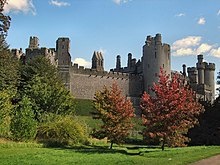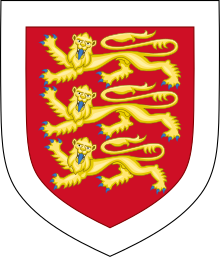
Joan Beaufort was the youngest of the four legitimised children and only daughter of John of Gaunt, 1st Duke of Lancaster, by his mistress, later wife, Katherine de Roet. She married Ralph de Neville, 1st Earl of Westmorland and in her widowhood became a powerful landowner in the north of England.

Margaret Holland was a medieval English noblewoman and a member of the powerful Holland family. Through her marriages she became Countess of Somerset and Duchess of Clarence. She was "at the very centre of royal power and prestige" throughout her lifetime.
John Holland, 1st Duke of Exeter, 1st Earl of Huntingdon, KG, of Dartington Hall in Devon, was a half-brother of King Richard II (1377–1399), to whom he remained strongly loyal. He is primarily remembered for being suspected of assisting in the downfall of King Richard's uncle Thomas of Woodstock, 1st Duke of Gloucester (1355–1397) and then for conspiring against King Richard's first cousin and eventual deposer, Henry Bolingbroke, later King Henry IV (1399–1413).

John Holland, 2nd Duke of Exeter, 2nd Earl of Huntingdon, was an English nobleman and military commander during the Hundred Years' War. His father, the 1st Duke of Exeter, was a maternal half-brother to Richard II of England, and was executed after King Richard's deposition. The Holland family estates and titles were forfeited, but John was able to recover them by dedicating his career to royal service. Earl of Huntingdon, of the Castle, town, manor of Barnstable and manors of Dartington, Fremington, South Molton, Torrington, Devon, Stevington, Bedfordshire, Ardington, Berkshire, Haslebury, Blagdon and Somerset. Holland rendered great assistance to his cousin Henry V in his conquest of France, fighting both on land and on the sea. He was marshal and admiral of England and governor of Aquitaine under Henry VI.
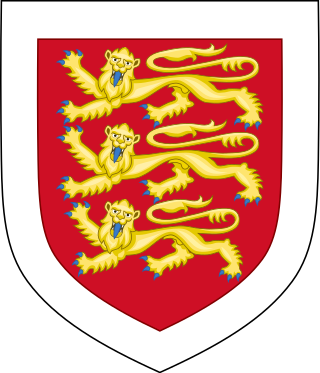
Thomas Holland, 2nd Earl of Kent was an English nobleman and a councillor of his half-brother, King Richard II of England.
The peerage title Earl of Kent has been created eight times in the Peerage of England and once in the Peerage of the United Kingdom. In fiction, the Earl of Kent is also known as a prominent supporting character in William Shakespeare's tragedy King Lear.
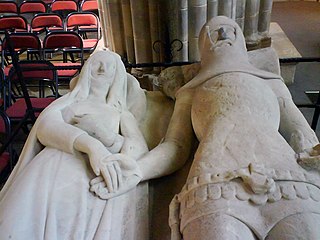
Richard Fitzalan, 3rd Earl of Arundel, 8th Earl of Surrey was an English nobleman and medieval military leader and distinguished admiral. Arundel was one of the wealthiest nobles, and most loyal noble retainer of the chivalric code that governed the reign of Edward III of England.

Edmund Mortimer, 3rd Earl of March and Earl of Ulster was an English magnate who was appointed Lieutenant of Ireland, but died after only two years in the post.
Margaret Wake, suo jure3rd Baroness Wake of Liddell and Countess of Kent, was the wife of Edmund of Woodstock, 1st Earl of Kent, the youngest surviving son of Edward I of England and Margaret of France.

The House of Plantagenet was a royal house which originated from the French county of Anjou. The name Plantagenet is used by modern historians to identify four distinct royal houses: the Angevins, who were also counts of Anjou; the main line of the Plantagenets following the loss of Anjou; and the Houses of Lancaster and York, two of the Plantagenets cadet branches. The family held the English throne from 1154, with the accession of Henry II, until 1485, when Richard III died.
Thomas Wake, 2nd Baron Wake of Liddell, English baron, belonged to a Lincolnshire family which had lands also in Cumberland, being the son of John Wake, 1st Baron Wake of Liddell, who was summoned to parliament as a baron in 1295, and the grandson of Baldwin Wake, both warriors of repute.
Alice Montacute was an English noblewoman and the suo jure 5th Countess of Salisbury, 6th Baroness Monthermer, and 7th and 4th Baroness Montagu, having succeeded to the titles in 1428.
Joan Holland was the third daughter of Thomas Holland, 2nd Earl of Kent, and Alice FitzAlan. She married four times. Her first husband was a duke, and the following three were barons. All of her marriages were most likely childless.
Joan FitzAlan, Countess of Hereford, Countess of Essex and Countess of Northampton was the wife of the 7th Earl of Hereford, 6th Earl of Essex and 2nd Earl of Northampton. She was the mother of Mary de Bohun, the first wife of Henry of Bolingbroke who later reigned as King Henry IV, and Eleanor de Bohun, Duchess of Gloucester. She was the maternal grandmother of King Henry V.
Isabel le Despenser was an English noblewoman. She was the eldest daughter of Hugh le Despenser, 2nd Baron le Despenser and Eleanor de Clare, suo jure 6th Lady of Glamorgan. Her mother was the eldest daughter of Joan of Acre, Princess of England; thus making Isabel a great-granddaughter of King Edward I by his first consort, Eleanor of Castile, while her father is famous for being the favourite of Edward II of England.
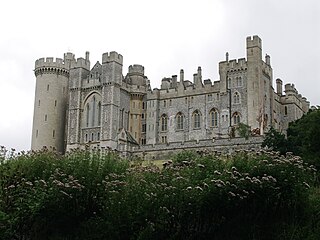
Lady Alice Holland, Countess of Kent, LG, formerly Alice FitzAlan, was an English noblewoman, a daughter of the 10th Earl of Arundel, and the wife of the 2nd Earl of Kent, the half-brother of King Richard II. As the maternal grandmother of Anne de Mortimer, she was an ancestor of kings Edward IV and Richard III, as well as King Henry VII and the Tudor dynasty through her daughter Margaret Holland. She was also the maternal grandmother of Joan Beaufort, Queen of Scots.

Alianore Holland, Countess of March was the eldest daughter of Thomas Holland, 2nd Earl of Kent, and the wife of Roger Mortimer, 4th Earl of March, heir presumptive to her uncle, King Richard II. Through her daughter, Anne Mortimer, she was the great-grandmother of the Yorkist kings Edward IV and Richard III. She was governess to Richard II's wife, Isabella of Valois.

Eleanor Holland, Countess of Salisbury, was an English noblewoman, the daughter of Thomas Holland, 2nd Earl of Kent, a half-brother of King Richard II of England. She was the first wife of Thomas Montagu, 4th Earl of Salisbury. One of her brothers was Edmund Holland, 4th Earl of Kent, to whom she was co-heiress. She is not to be confused with her eldest sister Alianore Holland, Countess of March who bore the same name.

William Montagu, 2nd Earl of Salisbury, 4th Baron Montagu, King of Mann, KG was an English nobleman and commander in the English army during King Edward III's French campaigns in the Hundred Years War. He was one of the Founder Knights of the Order of the Garter.
Maud Holland, LG, also known by her titles through marriage as Lady Courtenay and Countess of St Pol, was an English noblewoman. She was a daughter of Thomas Holland, 1st Earl of Kent and Joan of Kent. After Thomas' death Joan married Edward the Black Prince, who was then Prince of Wales. One of Joan and Edward's sons was the future King of England, Richard II. When she was aged around eight Edward arranged a marriage for Maud to Hugh Courtenay, whom she married, with royal and papal approval. Her husband, with whom she had no children, died in 1374. Maud was one of the first women to be invested as ladies of the Order of the Garter, when Richard II appointed many of his relatives to the order in 1378. In 1380 Maud married Waleran III, Count of Ligny, a French nobleman. After her death she was apparently buried in Westminster Abbey but the location of her grave is not known.

